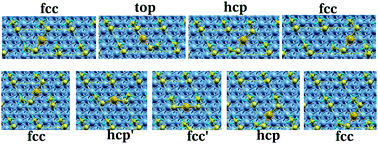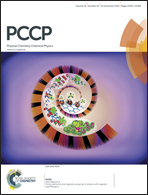A study on adatom transport through (√3 × √3)–R30°–CH3S self-assembled monolayers on Au(111) using first principles calculations
Abstract
Self-assembled monolayers on Au(111) have outstanding chemical, electrical, and optical properties, and Au adatoms seem to play a key role in these properties. Still, the fundamental understanding of adatom transport inside the self-assembled structure is very thin. In this paper we use first-principles calculations to reveal new details about the migration mechanism of Au adatoms in the presence of a CH3S self-assembled structure on Au(111). We study the inclusion of Au adatoms inside a well-packed (√3 × √3)–R30°–CH3S self-assembled lattice and present atomistic models supporting adatom migration by means of a hopping mechanism between pairs of CH3S species. Our calculations reveal that the transport of Au adatoms is slowed down inside the molecular network where the kinetic barrier for adatom migration is larger than on the clean Au surface. We attribute the hindered mobility of Au adatoms to the fact that adatom transport involves the breaking and making of Au–S bonds. Our results form a basis for further understanding the role played by defect transport in the properties of molecular assemblies.


 Please wait while we load your content...
Please wait while we load your content...